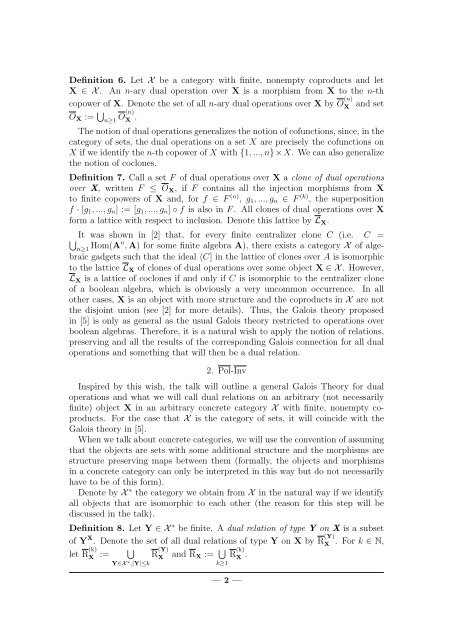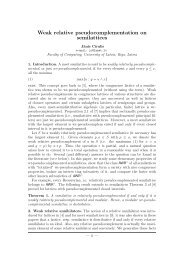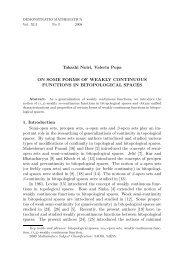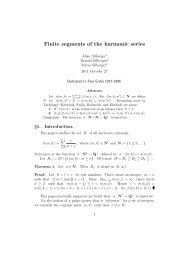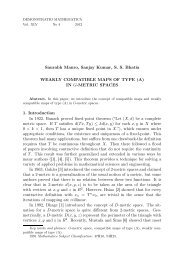A general Galois theory for dual operations and dual relations
A general Galois theory for dual operations and dual relations
A general Galois theory for dual operations and dual relations
Create successful ePaper yourself
Turn your PDF publications into a flip-book with our unique Google optimized e-Paper software.
Definition 6. Let X be a category with finite, nonempty coproducts <strong>and</strong> let<br />
X ∈ X . An n-ary <strong>dual</strong> operation over X is a morphism from X to the n-th<br />
copower of X. Denote the set of all n-ary <strong>dual</strong> <strong>operations</strong> over X by O (n)<br />
X <strong>and</strong> set<br />
OX := <br />
n≥1 O(n)<br />
X .<br />
The notion of <strong>dual</strong> <strong>operations</strong> <strong>general</strong>izes the notion of cofunctions, since, in the<br />
category of sets, the <strong>dual</strong> <strong>operations</strong> on a set X are precisely the cofunctions on<br />
X if we identify the n-th copower of X with {1, ..., n}×X. We can also <strong>general</strong>ize<br />
the notion of coclones.<br />
Definition 7. Call a set F of <strong>dual</strong> <strong>operations</strong> over X a clone of <strong>dual</strong> <strong>operations</strong><br />
over X, written F ≤ OX, if F contains all the injection morphisms from X<br />
to finite copowers of X <strong>and</strong>, <strong>for</strong> f ∈ F (n) , g1, ..., gn ∈ F (k) , the superposition<br />
f · [g1, ..., gn] := [g1, ..., gn] ◦ f is also in F . All clones of <strong>dual</strong> <strong>operations</strong> over X<br />
<strong>for</strong>m a lattice with respect to inclusion. Denote this lattice by LX.<br />
It was shown in [2] that, <strong>for</strong> every finite centralizer clone C (i.e. C =<br />
<br />
n≥1 Hom(An , A) <strong>for</strong> some finite algebra A), there exists a category X of algebraic<br />
gadgets such that the ideal 〈C] in the lattice of clones over A is isomorphic<br />
to the lattice LX of clones of <strong>dual</strong> <strong>operations</strong> over some object X ∈ X . However,<br />
LX is a lattice of coclones if <strong>and</strong> only if C is isomorphic to the centralizer clone<br />
of a boolean algebra, which is obviously a very uncommon occurrence. In all<br />
other cases, X is an object with more structure <strong>and</strong> the coproducts in X are not<br />
the disjoint union (see [2] <strong>for</strong> more details). Thus, the <strong>Galois</strong> <strong>theory</strong> proposed<br />
in [5] is only as <strong>general</strong> as the usual <strong>Galois</strong> <strong>theory</strong> restricted to <strong>operations</strong> over<br />
boolean algebras. There<strong>for</strong>e, it is a natural wish to apply the notion of <strong>relations</strong>,<br />
preserving <strong>and</strong> all the results of the corresponding <strong>Galois</strong> connection <strong>for</strong> all <strong>dual</strong><br />
<strong>operations</strong> <strong>and</strong> something that will then be a <strong>dual</strong> relation.<br />
2. Pol-Inv<br />
Inspired by this wish, the talk will outline a <strong>general</strong> <strong>Galois</strong> Theory <strong>for</strong> <strong>dual</strong><br />
<strong>operations</strong> <strong>and</strong> what we will call <strong>dual</strong> <strong>relations</strong> on an arbitrary (not necessarily<br />
finite) object X in an arbitrary concrete category X with finite, nonempty coproducts.<br />
For the case that X is the category of sets, it will coincide with the<br />
<strong>Galois</strong> <strong>theory</strong> in [5].<br />
When we talk about concrete categories, we will use the convention of assuming<br />
that the objects are sets with some additional structure <strong>and</strong> the morphisms are<br />
structure preserving maps between them (<strong>for</strong>mally, the objects <strong>and</strong> morphisms<br />
in a concrete category can only be interpreted in this way but do not necessarily<br />
have to be of this <strong>for</strong>m).<br />
Denote by X ∗ the category we obtain from X in the natural way if we identify<br />
all objects that are isomorphic to each other (the reason <strong>for</strong> this step will be<br />
discussed in the talk).<br />
Definition 8. Let Y ∈ X ∗ be finite. A <strong>dual</strong> relation of type Y on X is a subset<br />
of Y X . Denote the set of all <strong>dual</strong> <strong>relations</strong> of type Y on X by R (Y)<br />
X . For k ∈ N,<br />
<br />
let R (k)<br />
X :=<br />
Y∈X ∗ ,|Y|≤k<br />
R (Y)<br />
X <strong>and</strong> RX := <br />
k≥1<br />
R (k)<br />
X .<br />
— 2 —


